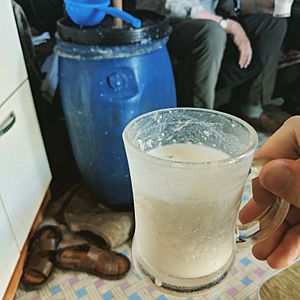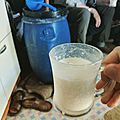Kumis facts for kids
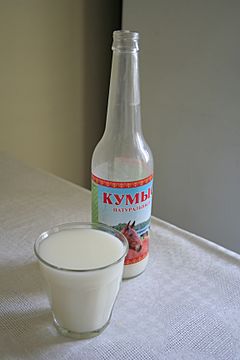
A bottle and glass of kumis
|
|
| Type | Dairy product |
|---|---|
| Main ingredients | Mare milk |
Kumis (also spelled kumiss or koumiss) is a special type of fermented milk drink. It is traditionally made from mare milk (milk from a female horse) or donkey milk. This drink is very important to people living in the Central Asian steppes, especially those of Turkic and Mongol origin. This includes groups like the Kazakhs, Kyrgyz, and Mongols.
Kumis is similar to another dairy product called kefir. However, kumis is made using a liquid "starter" that helps it ferment. Mare's milk has more natural sugars than cow's or goat's milk. Because of this, when it ferments, kumis gets a small amount of alcohol. It is a very mild drink.
It can be hard to get mare's milk in large amounts. So, when kumis is made in factories, they often use cow's milk. Cow's milk has more fat and protein, but less sugar (lactose) than mare's milk. To make it more like mare's milk, they might add sugar or other ingredients before it ferments.
Contents
What's in a Name?
The word Kumis comes from the Turkic word kımız. This word is used in many Turkic languages. For example, in Kazakh, it's қымыз (qymyz). In Mongolia, people call this drink airag (айраг).
An old book from the 11th century, called Dīwān Lughāt al-Turk, already mentioned the word kımız. This shows how old the drink is! A traveler named William of Rubruck wrote about cosmos (which was kumis) in the 13th century. He described how the Mongols made it.
How Mare Milk is Collected
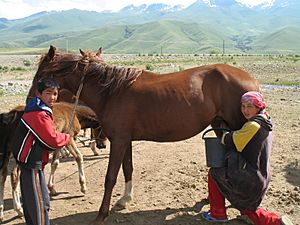
In 1982, it was reported that about 230,000 mares were kept in the Soviet Union just to produce milk for kumis. Milking a mare needs a lot of skill. People often kneel and use a special technique. A foal (baby horse) helps start the milk flow. The foal stays close to the mare during milking.
In Mongolia, horses are usually milked from mid-June to early October. During this time, one mare can produce about 1,000 to 1,200 liters of milk. About half of this milk is left for her foal.
Making Kumis
Kumis is made by fermenting raw (unpasteurized) milk. This process takes hours or even days. The milk is often stirred or churned while it ferments. This is a bit like making butter. During fermentation, special bacteria make the milk sour. Also, yeasts turn some of the sugar into a fizzy, mildly alcoholic drink.
Long ago, people fermented kumis in containers made from horse hide. These containers might be left on top of a yurt (a traditional tent) or tied to a saddle. This way, the movement from riding would help churn the milk. Today, people often use wooden vats or plastic barrels. In modern production, the first part of fermentation takes about two to five hours. It happens at a temperature of about 27°C (81°F). After that, it might be aged in a cooler place.
Kumis has a very low alcohol level, usually between 0.7% and 2.5%. This is similar to "small beer," which was a common drink in medieval Europe. Small beer helped people avoid drinking water that might not be clean. Kumis can also be made stronger by freezing it partly, a method that Central Asian nomads used. It can also be turned into a stronger drink called araka or arkhi.
A Look Back in Time
Kumis is a very old drink. Scientists have found signs of milk in bowls from the ancient Botai culture in Kazakhstan. This suggests that people there milked animals a long time ago. While they haven't found direct proof of fermented milk, it's very possible they made kumis.
The Greek historian Herodotus wrote about how mare's milk was processed in his book Histories around 5th century BC. Many believe this is the first description of how ancient kumis was made.
In the 13th century, William of Rubruck described how Mongols made cosmos (kumis). He said they poured mare's milk into a large skin and churned it with a stick. He noted that it would "boil up like new wine" and become sour. He also said it was "pungent on the tongue" and made a person feel "most joyful." Rubruck also mentioned a special black kumis called caracosmos, made from the milk of black mares.
How People Enjoy Kumis
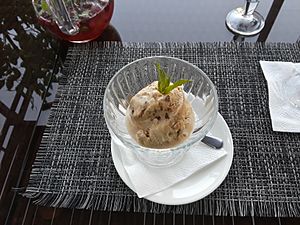
Kumis is unique because it's not made from fruit (like wine) or grain (like beer). It's made directly from milk sugars. It's very light and has a slightly sour taste. It also has a little fizz from the mild alcohol content. The exact taste can be different depending on who makes it.
People usually drink kumis cold. Traditionally, it's served in small, bowl-shaped cups without handles, called piyala. Serving kumis is an important part of showing hospitality in Kyrgyzstan. Especially in the summer pastures, where herders keep their animals.
Kumis in Culture
Kumis has played a big role in the cultures of Central Asia. During the Yuan dynasty in China, kumis was sometimes used instead of tea. Möngke Khan, a powerful leader of the Mongol Empire, even had a special drinking fountain in his capital city, Karakorum. This fountain offered kumis along with other drinks from different parts of his empire. This showed how diverse and large his empire was.
The capital city of Kyrgyzstan, Bishkek, is named after the paddle used to churn the milk for kumis. This shows how important the drink is to their national culture.
Some famous people have also mentioned kumis. The Russian writer Leo Tolstoy wrote about drinking kumis to escape his problems. The Russian composer Alexander Scriabin was even told to try a kumis diet by his doctor for his health.
Even today, the Japanese soft drink Calpis has a flavor inspired by the taste of kumis.
Images for kids
See also
 In Spanish: Kumis para niños
In Spanish: Kumis para niños


